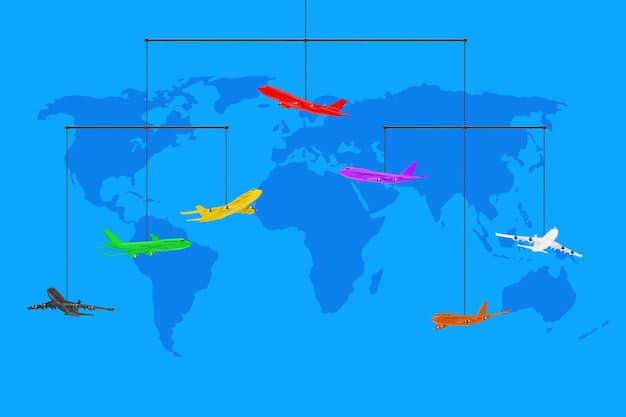Travel Hacking 101: Maximize Points & Miles with Our 2025 Strategy Guide

Travel hacking in 2025 involves strategic use of credit card points and airline miles, leveraging loyalty programs and dynamic pricing models to significantly reduce travel costs and enhance experiences, ensuring optimized rewards for every dollar spent.
Unlock the secrets to significantly reducing your travel expenses and elevate your journey experiences with our comprehensive guide. This article delves into Travel Hacking 101: Maximize Points and Miles with Our Updated 2025 Strategy Guide, offering actionable insights for both novice and seasoned travelers looking to master the art of smart travel.
Understanding the Evolving Landscape of Travel Hacking
Travel hacking, at its core, is the art of accumulating and redeeming loyalty points and miles for travel at maximum value, often far exceeding their perceived worth. In 2025, this landscape continues to evolve, shaped by dynamic airline and hotel pricing, changes in loyalty program structures, and the increasing sophistication of credit card offerings. Gone are the days when a single strategy guaranteed success; today’s environment demands adaptability and a deep understanding of nuanced program rules.
The shift towards revenue-based earning and redemption in many major programs means that points and miles are often tied more closely to the cash price of a ticket or stay. This doesn’t diminish their value but rather redirects the hacker’s focus towards finding sweet spots and maximizing earning opportunities. It’s no longer just about hoarding points but strategically acquiring and deploying them where they yield the greatest return, whether that’s an aspirational first-class flight or a multitude of budget-friendly stays.
The Impact of Dynamic Pricing
Dynamic pricing means that the number of points or miles required for a redemption can fluctuate based on demand, time of year, and even specific routes. This requires a more vigilant approach from travel hackers.
- Flexibility is Key: Being open to traveling during off-peak seasons or on less popular routes can significantly reduce the points required for redemptions.
- Booking in Advance: For popular routes and peak travel times, booking far in advance can often lock in lower redemption rates before demand drives them up.
- Comparing Options: Always check both cash prices and points prices, as sometimes the cash price might offer better value, especially for short-haul flights or budget accommodations.
Moreover, the concept of “peak” and “off-peak” changes. Airlines and hotels now have multiple tiers of dynamic pricing, making a deep dive into specific program calendars and award charts (when available) essential. Understanding these fluctuations is paramount to extracting maximum value from your accumulated rewards. It’s a continuous learning process, much like stock market analysis for the savvy investor.
Staying informed about program updates and industry trends is a full-time endeavor for serious travel hackers. Online communities, specialized blogs, and dedicated forums serve as vital resources for sharing new strategies, identifying loopholes, and alerting members to changes that could impact their point-earning and redemption goals. This collaborative intelligence is a cornerstone of successful travel hacking in the modern age.
Optimizing Credit Card Strategies for Maximum Rewards
Credit cards remain the cornerstone of any effective travel hacking strategy. In 2025, the proliferation of specialized travel cards, coupled with competitive sign-up bonuses and category spending multipliers, offers unprecedented opportunities for accumulating points and miles rapidly. The key lies in strategic card selection, responsible spending, and meticulously managing welcome bonuses.
Choosing the right credit card is not merely about finding the highest sign-up bonus. It involves a holistic assessment of your spending habits, travel preferences, and long-term financial goals. Cards that offer bonus points on categories where you spend the most – be it groceries, dining, or travel itself – can significantly accelerate your earning potential beyond initial welcome offers. Pairing cards with complementary bonus categories is a sophisticated tactic that allows for optimized earning across all aspects of your daily life.
Strategic Card Applications and Welcome Bonuses
Welcome bonuses are undeniably the most lucrative aspect of travel credit cards. These substantial point or mile sums are earned after meeting a specified spending requirement within a initial few months of account opening. Timing your applications and managing multiple cards responsibly is crucial to maximize this strategy without impacting your credit score negatively.
- Understanding Application Rules: Be aware of each issuer’s specific rules regarding new card applications (e.g., Chase’s 5/24 rule or Amex’s once-per-lifetime bonus rule) to avoid wasting applications.
- Meeting Minimum Spending: Plan your spending to comfortably meet the minimum requirement for the bonus. This often involves channeling routine expenses, but never spend beyond your means just to earn points.
- Diversifying Issuers: Applying for cards from different banks can help you navigate individual application restrictions and access a wider array of loyalty programs.
Moreover, consider the card’s annual fee. While many premium travel cards come with high annual fees, they often offer benefits such as travel credits, lounge access, or elite status that can easily offset the cost, especially if utilized effectively. Calculate the net value of these benefits before committing to a card, ensuring it aligns with your travel patterns and spending capacity.

Beyond welcome bonuses, focus on cards that offer strong earning rates on your largest spending categories. If you frequently dine out, a card with 3x or 4x points on restaurant purchases will be more valuable than one offering bonus points on gas, assuming gas isn’t a primary expense for you. The goal is to align your card portfolio with your natural spending, making point accumulation seamless and organic.
Mastering Airline and Hotel Loyalty Programs
Earning points through credit cards is just one piece of the puzzle; understanding and leveraging airline and hotel loyalty programs directly is equally critical for comprehensive travel hacking. Each program has unique earning structures, elite status tiers, and redemption sweet spots. Maximizing these programs requires an in-depth understanding of their specific nuances and strategic alignment with your travel patterns.
Airline loyalty programs often reward frequent flyers with elite status benefits like complimentary upgrades, priority boarding, and increased baggage allowances. While reaching these tiers typically requires significant paid flying, co-branded credit cards or strategic spending can sometimes fast-track your path. Similarly, hotel loyalty programs offer benefits ranging from free breakfast and room upgrades to late check-out and free night certificates based on stays or credit card spend.
Navigating Airline Programs for Award Travel
Airline programs differ significantly in how they value points and how easy it is to find award availability. Some, like those with dynamic pricing, offer broad availability but variable point costs. Others, with fixed award charts, can provide outsized value for specific routes, though finding availability might be more challenging.
- Understanding Alliances: Knowing which airlines belong to which alliances (Star Alliance, SkyTeam, Oneworld) can unlock broader redemption options across partner airlines using your miles.
- Searching Strategically: Utilize flexible date searches and consider flying into or out of smaller airports near your destination, as these might have better award availability.
- Leveraging Stopovers/Open-Jaws: Some programs allow for free or inexpensive stopovers or open-jaw itineraries, effectively letting you visit multiple cities for the price of one award.
Moreover, the value of an airline mile can fluctuate wildly. A mile used for a domestic economy flight might yield 1.5 cents in value, while the same mile used for an international first-class redemption could be worth 5 cents or more. This pursuit of “outsized value” is a core tenet of advanced airline travel hacking, pushing travelers to find redemptions that offer significantly more than the cash equivalent.
Maximizing Hotel Loyalty Programs
Hotel loyalty programs offer a different set of opportunities, often focusing on free nights, room upgrades, and additional perks. Just like airlines, understanding the tiers and benefits of each program is essential.
- Status Matching: If you have elite status with one hotel chain, you might be able to status match with a competitor, immediately unlocking benefits without extensive stays.
- Free Night Certificates: Many hotel credit cards offer annual free night certificates that can be incredibly valuable, especially when used creatively at high-value properties.
- Points Transfers: Some credit card rewards programs allow transfers to multiple hotel loyalty programs, offering flexibility when choosing where to redeem your points.
For hotels, the concept of “brand hopping” between different chains to take advantage of various promotions or sign-up bonuses is also prevalent. This allows for a diverse portfolio of points across different programs, providing flexibility for various travel scenarios. Always compare the cash rate with the points rate to ensure you’re getting optimal value. Sometimes, paying cash might be a better option if the points redemption rate is poor, saving your valuable points for a more lucrative future redemption.
Advanced Hacking Techniques for 2025
As the travel hacking landscape matures, so too do the strategies employed by seasoned enthusiasts. Beyond the foundational principles of credit card optimization and loyalty program mastery, advanced techniques emerge that can further amplify your points and miles portfolio. These often involve a deeper dive into niche opportunities, strategic manufactured spending, and leveraging partner ecosystems.
One key advanced technique is understanding and exploiting “transfer bonuses.” Periodically, credit card reward programs (like Chase Ultimate Rewards or Amex Membership Rewards) will offer bonuses when you transfer points to specific airline or hotel partners. These can range from 15% to 50% extra points, transforming a good redemption into an extraordinary one. Being patient and waiting for these bonuses can significantly stretch your points, making dream trips more attainable.
Leveraging Partner Transfers and Sweet Spots
The true power of transferable points often lies in their flexibility and the ability to unlock partner award charts. While booking directly through a credit card portal might seem straightforward, transferring points to an airline partner can frequently yield significantly better value, especially for premium cabin international travel.
- Identifying Sweet Spots: Researching specific routes or regions where a particular airline’s award chart offers exceptional value, often through partner airlines that operate the route.
- Utilizing Positioning Flights: Booking a cheap cash flight or short “positioning” award flight to a major airline hub if the main long-haul award flight is cheaper from that hub.
- Award Chart Gaps: Exploiting discrepancies or mispricings in older or less frequently updated award charts of certain loyalty programs before they are revised.

Beyond standard transfers, a mastery of “nested” redemptions or the combination of loyalty programs can lead to significant savings. This might involve using hotel points for a free night certificate at an airport hotel, and then airline miles for a flight, effectively breaking down a complex journey into multiple cost-effective segments. It requires meticulous planning and a deep understanding of multiple loyalty programs, but the rewards can be substantial.
Manufactured Spending and Ethical Considerations
Manufactured spending (MS) refers to methods of generating credit card spend without making actual purchases, solely for the purpose of accumulating points or reaching spending thresholds. While once a more prevalent and overt strategy, its forms in 2025 are subtler and require careful consideration of terms and conditions, as well as ethical boundaries.
- Gift Card Resale (Limited): Purchasing specific gift cards with a credit card and then reselling them—this method has become increasingly difficult and risky due to stricter rules and fraud detection.
- Bill Pay Services (Targeted): Using services that allow you to pay bills (e.g., rent, mortgage) with a credit card for a small fee, which might be offset by the points earned.
- MS is Not for Beginners: It involves inherent risks (e.g., account shutdowns, devaluations) and should only be considered after mastering basic travel hacking and understanding the associated risks.
It’s crucial to distinguish between smart financial management that maximizes rewards and activities that skirt the rules or violate the spirit of loyalty programs. Banks and loyalty programs are vigilant about detecting misuse, and engaging in risky manufactured spending techniques can lead to account closures and forfeiture of earned points. Always prioritize ethical practices and maintaining a good relationship with your financial institutions over aggressive, high-risk strategies.
Avoiding Common Pitfalls and Staying Updated
Even for experienced travel hackers, the dynamic nature of points and miles can present unforeseen challenges. Avoiding common pitfalls is as crucial as mastering earning strategies, especially in a rapidly evolving rewards landscape. These pitfalls range from failing to understand program terms to succumbing to the allure of a bad deal, ultimately eroding the value of your hard-earned points.
One prevalent pitfall is devaluation. Loyalty programs can, and do, change their award charts or earning structures with little notice, sometimes drastically reducing the value of your accumulated points. This risk underscores the importance of having a redemption strategy and using points proactively rather than hoarding them indefinitely. Understanding that points are a depreciating asset encourages a timely and pragmatic approach to redemptions.
Key Pitfalls to Dodge
To ensure your travel hacking journey remains profitable and enjoyable, be mindful of these common mistakes.
- Overspending for Points: Never spend money you wouldn’t otherwise spend just to earn points or hit a minimum spending requirement. Debt accumulation far outweighs any travel benefits.
- Ignoring Annual Fees: Always calculate if the benefits and points earned from a card truly offset its annual fee. Some premium cards might not be worth keeping long-term.
- Forgetting Expiration Dates: Points and miles can expire if there’s no account activity. Keep track of program rules and make a small transaction or redemption to keep them active.
- Blindly Transferring Points: Once points are transferred to an airline or hotel program, they typically cannot be reversed. Ensure you have concrete travel plans and confirmed availability before initiating a transfer.
Another often overlooked pitfall is carrying a credit card balance. The interest accrued on a balance can quickly negate any value gained from points and miles. Travel hacking is fundamentally about financial optimization, and carrying high-interest debt directly contradicts this principle. Pay off your credit card balances in full every month; if you can’t, pause your travel hacking efforts until your financial house is in order.
Staying Informed in 2025
The travel hacking ecosystem thrives on up-to-date information. What was a great deal last year might be a poor one today. Remaining informed is critical to adapting your strategy and capitalizing on new opportunities.
- Follow Reputable Blogs: Subscribe to newsletters and regularly read established travel hacking blogs that provide timely updates on program changes, new card offers, and redemption strategies.
- Join Online Communities: Participate in forums or online groups where members share their experiences, ask questions, and report new findings. This collective intelligence is invaluable.
- Set Up Deal Alerts: Use tools or extensions that alert you to new credit card sign-up bonuses, transfer bonuses, or specific award availability that matches your travel goals.
Finally, always read the fine print. Terms and conditions for credit cards and loyalty programs can be complex and are subject to change. A superficial understanding can lead to missed bonuses, unexpected fees, or failed redemptions. Diligence in understanding the rules of the game is what separates the casual points collector from the truly impactful travel hacker.
Crafting Your Personalized Travel Hacking Plan
With an understanding of the evolving landscape, credit card optimization, loyalty program nuances, and advanced techniques, the next crucial step is to consolidate this knowledge into a personalized travel hacking plan for 2025. This isn’t a one-size-fits-all endeavor; an effective plan is tailored to your individual travel aspirations, spending habits, and financial capacity. A well-structured plan acts as your roadmap, guiding your decisions and ensuring every point and mile earned serves a specific purpose.
Starting with a clear vision of your travel goals is paramount. Do you dream of flying first class to Asia, or are you aiming for a series of budget-friendly domestic trips? Your end goal will dictate the type of points you prioritize earning (airline vs. hotel, transferable vs. specific program) and the credit cards you pursue. Without a target, your efforts might be scattered, leading to a suboptimal collection of points that don’t align with your aspirations.
Defining Your Travel Goals and Budget
Before diving into specific cards or programs, take time to define what travel hacking means for you.
- Aspirational Trips: Identify one or two ‘dream’ trips. Research the points or miles needed for these specific flights and hotels. This gives you a concrete target.
- Annual Travel Needs: Consider your regular travel. Do you take frequent short trips for business or leisure? Focus on cards that reward these patterns.
- Financial Comfort: Assess your disposable income and credit score. Only apply for cards you can comfortably manage and pay off in full each month. Over-extending financially negates all benefits.
Your budget isn’t just about how much you can spend, but how much you can spend strategically. Can you shift everyday expenses (like groceries or utility bills) to a credit card to meet spending requirements? Are you comfortable with annual fees if the benefits outweigh the cost? These are critical questions to answer before you begin applying for cards.
Executing and Adapting Your Strategy
Once your goals are set and your budget is clear, it’s time to build your strategy. This involves selecting specific credit cards, designing a spending plan, and keeping track of your progress.
- Card Churning Schedule: Plan which cards to apply for and when, considering application rules and minimum spending timelines. Space out applications to protect your credit score.
- Tracking Systems: Utilize spreadsheets or dedicated apps to monitor points balances, application dates, minimum spending progress, and annual fee dates.
- Regular Review: The travel hacking landscape is fluid. Quarterly or semi-annual reviews of your plan are essential to adapt to program changes, new card offers, or shifts in your travel goals.
Remember, patience and persistence are virtues in travel hacking. Big redemptions often require significant planning and accumulation. Don’t get discouraged by short-term devaluations or missed opportunities. Instead, view them as learning experiences and adjust your strategy accordingly. The most successful travel hackers are those who are not only knowledgeable but also adaptable and committed to continuous learning.
By diligently following these principles – defining clear goals, making informed decisions on credit cards and loyalty programs, and continuously adapting to the evolving landscape – you can transform your travel dreams into tangible realities. Travel hacking in 2025 is more accessible and rewarding than ever for those willing to invest the time and strategic effort.
| Key Strategy | Brief Description |
|---|---|
| 💳 Optimize Credit Cards | Choose cards for high sign-up bonuses and aligned spending categories. |
| ✈️ Master Loyalty Programs | Understand airline/hotel program rules, elite status, and redemption sweet spots. |
| 🔄 Use Transfer Bonuses | Leverage temporary boosts when transferring points to maximize value. |
| ⚠️ Avoid Common Pitfalls | Prevent overspending, devalutions, and expired points to protect your efforts. |
Frequently Asked Questions About Travel Hacking
▼
Travel hacking is the strategic accumulation and redemption of airline miles, hotel points, and credit card rewards to significantly reduce travel costs. It involves understanding loyalty programs, leveraging sign-up bonuses, and using responsible spending habits to maximize travel benefits, allowing individuals to experience destinations and accommodations at a fraction of their retail price.
▼
Yes, travel hacking is generally both ethical and legal. It involves leveraging publicly available credit card offers and loyalty program rules as intended by financial institutions and travel providers. The key is to operate within the terms and conditions set by these entities, avoiding any practices that could be considered fraudulent or manipulative, ensuring a sustainable and rewarding experience for all parties involved.
▼
The speed of earning points largely depends on your spending capacity, ability to meet credit card sign-up bonuses, and the specific travel goals you have. Many individuals can earn enough points for a domestic trip in just a few months by strategically utilizing one or two new credit card welcome offers. For international or first-class travel, it may take 6-12 months of consistent effort.
▼
Initially, applying for new credit cards can cause a small, temporary dip in your credit score due to a “hard inquiry.” However, if managed responsibly—meaning paying off balances in full and on time—travel hacking can actually improve your score over the long term by increasing your overall credit limit and diversifying your credit mix, demonstrating responsible credit utilization.
▼
The cardinal rule of travel hacking is simple: never spend money you wouldn’t otherwise spend, and always pay your credit card balances in full and on time. Accumulating debt with high-interest rates will quickly negate any value gained from points and miles, turning a beneficial strategy into a financial burden. Financial discipline is the bedrock of successful travel hacking.
Conclusion
As we’ve explored in this 2025 strategy guide, travel hacking is far more than just collecting points; it’s a sophisticated discipline rooted in strategic financial planning and an acute understanding of loyalty ecosystems. From optimizing credit card acquisition to mastering intricate loyalty programs and navigating the nuances of dynamic pricing, the landscape demands consistent learning and adaptability. By committing to responsible spending, avoiding common pitfalls, and diligently crafting a personalized plan, any aspiring traveler can unlock a world of significantly reduced travel expenses and elevated experiences, transforming distant dreams into achievable realities.





